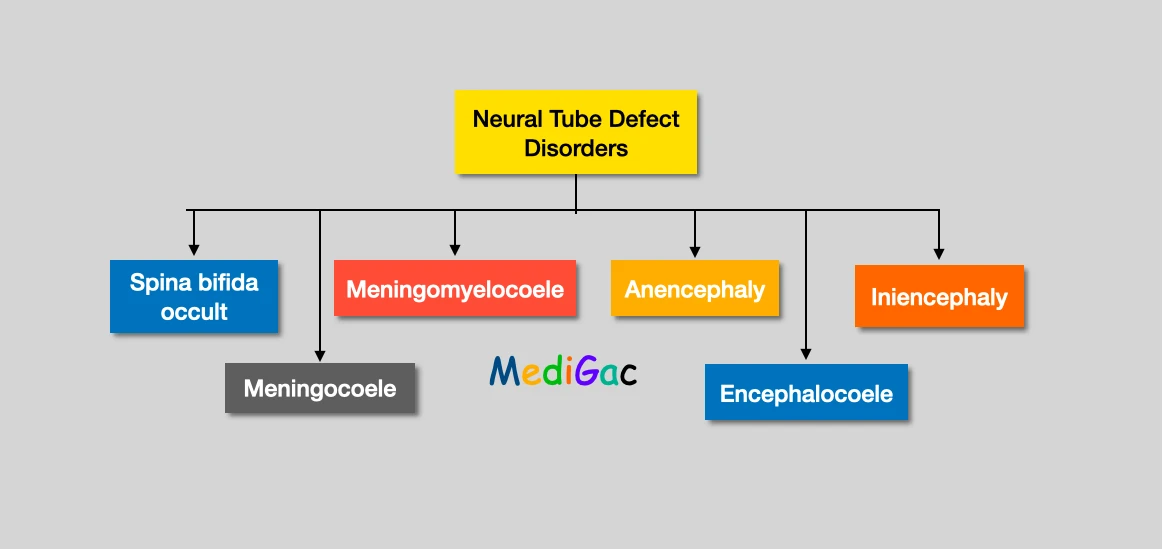We have two types of anomalies, and they are – 1. Neural tube defect, 2. Neuronal migration disorders.
A. Neural tube defect :

1. Spina bifida occult :
When a baby’s backbone (spine) does not fully form during pregnancy, it is known as spina bifida occulta. The kid is born with a little gap between the spine’s bones. Spina bifida occulta is a frequent condition that affects roughly one out of every ten persons. Spina bifida occulta usually has no health consequences.
Presenting clinical features :
Deformity of the foot. Leg clumsiness, numbness, or weakness.
2. Meningocoele :
A meningocele is a congenital condition in which a sac protrudes from the spinal column. There is no neural tissue in the sac, but it does contain spinal fluid. It could be covered by skin or meninges (the membranes that cover the central nervous system). The sac is frequently visible from the backside.
Presenting clinical features :
- In the back, there is a little aperture.
- At birth, there is a visible sack.
- Membranes push into the sack through the orifice in the spine.
- spinal cord growth that is normal
3. Meningomyelocoele :
Myelomeningocele, often known as meningomyelocele, is a form of spina bifida. A birth abnormality in which the spinal canal and backbone do not close before the baby is born is known as spina bifida. A neural tube defect is another name for this sort of birth abnormality.
Presenting clinical features :
- In the back, there is a little aperture.
- At birth, there is a visible sack.
- Membranes push into the sack through the orifice in the spine.
- spinal cord growth that is normal
4. Anencephaly :
Anencephaly is a significant birth abnormality in which a baby is born with missing brain and skull structures. It’s a particular kind of neural tube defect (NTD). The neural tube assists in the formation of the baby’s brain and skull (upper part of the neural tube), spinal cord, and back bones as it forms and closes (lower part of the neural tube).
Presenting clinical features :
- There isn’t any bony covering on the back of the head.
- Bones on the front and sides of the head are absent.
- The ears are folded.
- Cleft palate is a disorder in which a child’s roof of mouth does not seal entirely, creating an opening that might extend into the nasal canal.
5. Encephalocoele :
Encephalocele is a sac-like protrusion or projection of the brain and its covering membranes through a hole in the skull. The neural tube does not close entirely during pregnancy, resulting in encephalocele.
Presenting clinical features :
- Problems with the nervous system.
- Cerebrospinal fluid has accumulated in the brain, causing hydrocephalus.
- Quadriplegia (spastic quadriplegia) is a paralysis of the limbs.
- Microcephaly is a condition in which the head is abnormally tiny.
- Uncoordinated muscle action is referred to as ataxia.
- Delay in development.
- Issues with vision.
- Retardation of both mental and physical development.
6. Iniencephaly :
Iniencephaly is a rare and complex neural tube defect (NTD) involving the occiput and inion that causes significant head retroflexion and is frequently associated with occipital encephalocele or cervical or thoracic spine rachischisis.
Presenting clinical features :
- Head – slanted (retroflexed) with upward-looking face; short neck or missing neck (due to fusion of the cervical and thoracic vertebrae). An occipital encephalocele affects some babies.
- Closing — the skull is closed and skinned. The skin of the face appears to be directly attached to the skin of the chest, and the skin of the scalp appears to be directly connected to the skin of the back due to internal spine anomalies.
- Spine – generally closed, however the cervical spine may be open.
B. Neuronal migration disorder :

1. Lissencephaly :
Lissencephaly, which literally means “smooth brain,” is a rare, gene-linked brain malformation characterised by an abnormally small head and the absence of typical convolutions (folds) in the cerebral cortex (microcephaly). In the most common kind of lissencephaly, children are born with a normal-sized skull.
Presenting clinical features :
- Swallowing difficulties
- Failure to thrive
- Muscle spasms
- Deformed hands, fingers, or toes are possible.
- Convulsions, and severe psychomotor retardation are all common symptoms.
2. Schizencephaly :
Schizencephaly is an uncommon congenital birth disorder marked by aberrant slits, or clefts, in the cerebral hemispheres.
Presenting clinical features :
- Delay in development.
- Seizures.
- A head that is unusually tiny ( microcephaly )
- Intellectual impairment is a condition that affects people.
- Paralysis, either partial or full.
- Muscle tone issues ( hypotonia )
- Hydrocephalus.
3. Porencephaly :
Porencephaly is a very rare central nervous system condition in which the brain develops a cyst or cavity filled with cerebrospinal fluid.
Presenting clinical faetures :
- Spastic hemiplegia (slight or total paralysis),
- Hypotonia (low muscular tone),
- Seizures (frequently infantile spasms), and macrocephaly (big head) or microcephaly (small head) are all symptoms of delayed growth and development (small head)
4. Polymicrogyria :
Polymicrogyria is a condition in which the brain develops abnormally before birth. The ridges or folds on the surface of the brain are known as gyri. Polymicrogyria is a condition in which the brain produces too many folds and the folds are unusually small.
Presenting clinical faetures :
- Recurrent seizures (epilepsy)
- Delayed growth
- Crossed eyes
- Speech and swallowing difficulties, and muscle weakness or paralysis are all symptoms of epilepsy.